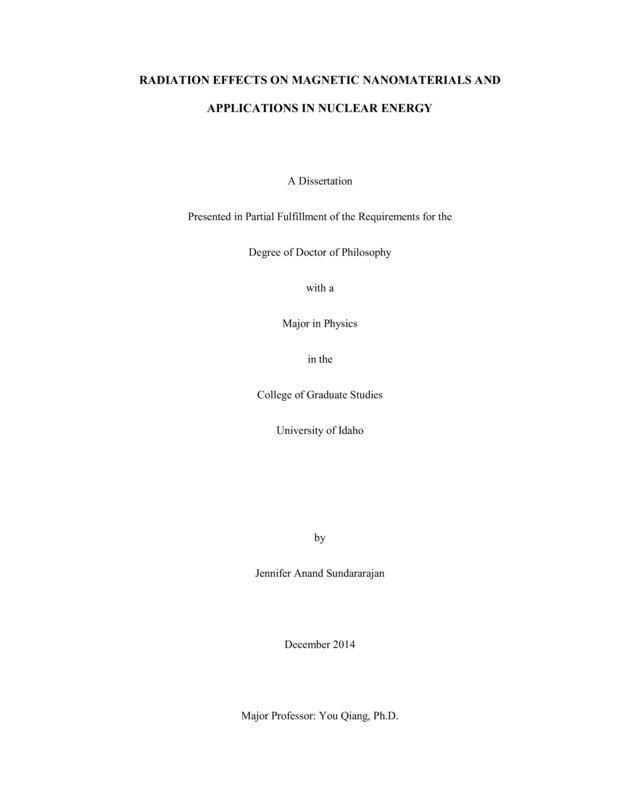RADIATION EFFECTS ON MAGNETIC NANOMATERIALS AND APPLICATIONS IN NUCLEAR ENERGY
Sundararajan, Jennifer Anand. (2014). RADIATION EFFECTS ON MAGNETIC NANOMATERIALS AND APPLICATIONS IN NUCLEAR ENERGY. Theses and Dissertations Collection, University of Idaho Library Digital Collections. https://www.lib.uidaho.edu/digital/etd/items/sundararajan_idaho_0089e_10429.html
- Title:
- RADIATION EFFECTS ON MAGNETIC NANOMATERIALS AND APPLICATIONS IN NUCLEAR ENERGY
- Author:
- Sundararajan, Jennifer Anand
- Date:
- 2014
- Embargo Remove Date:
- 2019-12-17
- Keywords:
- Magnetic Nanomaterials Nano Nuclear Technology Nanoparticles Nuclear reactors Radiation Sensor/Monitors
- Program:
- Physics
- Subject Category:
- Condensed matter physics; Nanotechnology; Materials Science
- Abstract:
-
Future generation IV nuclear reactors are expected to meet the standards of enhanced safety, minimal waste and economical compatibility. Through Nano-Nuclear Technology, latest engineered-nanomaterials are used for improving the nuclear power performance and safety. This research contributes in part to meet this objective through the understanding of responsibility and stability of magnetic nanomaterials under irradiation by studying changes of nanostructure, magnetic and electrical properties in irradiated nanomaterials. Previous publications have shown fully oxidized nanoparticle structures like Yttria (Y2O3) and Alumina (Al2O3) dispersed in commercial Ferritic/Martensitic alloy, also called as Nano Ferritic Alloys (NFA) have improved creep properties, hardness, tensile strength, corrosion resistant, and thermal stability compared with the normal reactor alloys. Since our Fe-based nanoparticles (NPs) like core-shell Fe-Fe oxide, fully oxidized Fe3O4, Ni/Ni-Cr and FeO NPs have proved to alter the radiation effects and radiation resistance behavior, these iron oxide particles could be good candidates for studying the dispersion strengthening phenomena in materials as it promotes grain boundaries and interfacial effects. Based on our primary results obtained from the irradiated Fe-Fe3O4 core-shell and fully oxidized Fe3O4 NPs, we hypothesized that this approach will help us uncover the interfacial behavior between nanomaterials and inter-particle interactions under extreme intense radiation exposure. The combined effect of vacancy formation, atom diffusion under the influence of temperature and breaking of chemical bonds are reported to be the main cause behind the mystery of electron beam induced oxide layer thickening in core-shell iron nanoparticles, which ultimately results in structural changes followed by magnetic property changes. The results obtained from this investigation could help generate data for future scientific assessment in the prediction of material performance in radiation environments and to recommend candidate nanomaterials for development of high sensitive nuclear monitor and detector for safety application in nuclear energy.
- Description:
- doctoral, Ph.D., Physics -- University of Idaho - College of Graduate Studies, 2014
- Major Professor:
- Qiang, You
- Committee:
- Machleidt, Ruprecht; Bergman, Leah; Utgikar, Vivek
- Defense Date:
- 2014
- Identifier:
- Sundararajan_idaho_0089E_10429
- Type:
- Text
- Format Original:
- Format:
- application/pdf
- Rights:
- In Copyright - Educational Use Permitted. For more information, please contact University of Idaho Library Special Collections and Archives Department at libspec@uidaho.edu.
- Standardized Rights:
- http://rightsstatements.org/vocab/InC-EDU/1.0/

